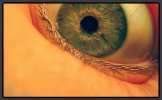
We present a new method for training deformable models. Assume that we have training images where part locations have been labeled. Typically, one fits a model by maximizing the likelihood of the part labels. Alternatively, one could fit a model such that, when the model is run on the training images, it finds the parts. We do this by maximizing the conditional likelihood of the training data. We formulate model-learning as parameter estimation in a conditional random field (CRF). Initializing parameters with their maximum likelihood estimates, we reach the global optimum by gradient ascent. We present a learning algorithm that searches exhaustively over all part locations in an image without relying on feature detectors. This provides millions of examples of training data, and seems to avoid over-fitting issues known with CRFs. Results for part localization are relatively scarce in the community. We present results on three established datasets; Caltech motorbikes [8], USC people [19], and Weizmann horses [3]. In the Caltech set we significantly outperform the state-of-the-art [6]. For the challenging people dataset, we present results that are comparable to [19], but are obtained using a significantly more generic model (devoid of a face or skin detector). Our model is general enough to find other articulated objects; we use it to recover poses of horses in the challenging Weizmann database.
Download: pdf
Text Reference
Deva Ramanan and Cristian Sminchisescu.
Training deformable models for localization.
In
CVPR, I: 206–213. 2006.
BibTeX Reference
@inproceedings{RamananS_CVPR_2006,
AUTHOR = "Ramanan, Deva and Sminchisescu, Cristian",
tag = "object_recognition,people",
TITLE = "Training Deformable Models for Localization",
BOOKTITLE = "CVPR",
YEAR = "2006",
PAGES = "I: 206-213",
BIBSOURCE = "http://www.visionbib.com/bibliography/twod293.html#TT20453"
}
